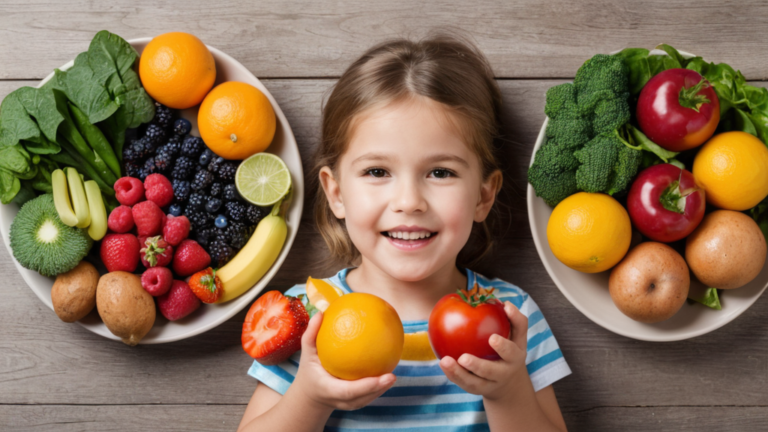Strategies to Avoid Processed and Canned Foods
Table of Contents
Introduction

In today’s fast-paced world, processed and canned foods have become a convenient staple in many households. For busy parents, these foods can seem like an easy solution for quick meals, but their impact on children’s health is far from ideal. Processed and canned foods are often high in unhealthy fats, sugars, sodium, and artificial additives, which can contribute to obesity, type 2 diabetes, and even behavioral issues in children. As a result, there is a growing need to understand the importance of reducing processed foods and developing healthier eating habits for children.
This article will discuss the negative effects of processed and canned foods, provide strategies to help parents avoid them, and offer healthier alternatives. With a focus on cognitive research and evidence-based strategies, we will also include practical tips, statistics, and a FAQ section to support families in making healthier choices.
1. Understanding Processed and Canned Foods
Processed foods are defined as foods that have been altered in some way during preparation. This can include anything from adding preservatives to extending shelf life to enhancing flavor with sugar, salt, or artificial additives. Canned foods are often part of the processed food category because they undergo various treatments, such as high-temperature cooking and the addition of preservatives, to ensure longevity.
While not all processed foods are harmful, many are loaded with unhealthy ingredients that can negatively affect children’s health. For example:
- Trans fats in processed foods can raise bad cholesterol (LDL) and lower good cholesterol (HDL), contributing to heart disease later in life.
- Added sugars in many processed snacks can lead to obesity, tooth decay, and metabolic problems.
- High sodium in canned soups and ready-made meals can increase blood pressure and contribute to cardiovascular issues.
Table 1: Common Ingredients Found in Processed and Canned Foods
| Ingredient | Common Sources | Health Impact |
|---|---|---|
| Trans fats | Packaged baked goods, margarine | Increases LDL cholesterol, raises heart disease risk |
| Added sugars | Soda, candy, cereals | Leads to obesity, type 2 diabetes, tooth decay |
| Sodium | Canned soups, frozen dinners, deli meats | Raises blood pressure, contributes to heart disease |
| Artificial additives | Flavored snacks, processed meats | Linked to behavioral issues, allergies |
2. Why Processed and Canned Foods Are Harmful to Children

Children’s bodies and brains are in critical stages of growth and development. The consumption of processed and canned foods during these early years can have long-term effects, making it important to address this issue.
2.1 Nutrient Deficiency
Processed foods are often stripped of essential nutrients like vitamins, minerals, and fiber during production. This means that children who consume these foods regularly may be missing out on the nutrients needed for proper growth and development. For instance, a diet lacking in iron can lead to anemia, while insufficient calcium can affect bone development.
2.2 Obesity and Metabolic Disorders
The high sugar and fat content in processed foods contribute to childhood obesity, which has been on the rise in the United States. According to the Centers for Disease Control and Prevention (CDC), the prevalence of obesity in children aged 6-11 years was about 20% in 2017-2018 . Childhood obesity increases the risk of developing type 2 diabetes, heart disease, and other metabolic disorders.
2.3 Behavioral and Cognitive Issues
Studies have shown that artificial additives and preservatives found in processed foods may contribute to behavioral problems, such as hyperactivity and attention-deficit/hyperactivity disorder (ADHD). Additionally, diets high in processed foods have been linked to lower academic performance due to the lack of nutrients that support cognitive function.
3. Strategies to Avoid Processed and Canned Foods
Although it can be challenging to completely eliminate processed and canned foods from a child’s diet, there are practical strategies parents can use to significantly reduce their intake. Here are some effective methods:
3.1 Prioritize Whole Foods
Whole foods refer to foods that are minimally processed and remain as close to their natural state as possible. Fruits, vegetables, whole grains, nuts, seeds, and lean proteins should form the basis of a child’s diet. By focusing on whole foods, parents can ensure their children receive the nutrients they need without the unhealthy additives commonly found in processed options.
Examples of Whole Foods to Incorporate into a Child’s Diet:
- Fresh fruits and vegetables
- Whole grains such as quinoa, brown rice, and oats
- Lean proteins like chicken, fish, tofu, and legumes
- Nuts and seeds
3.2 Meal Planning and Preparation
One of the main reasons families rely on processed and canned foods is the convenience they offer. However, with a little planning, parents can create healthier, home-cooked meals that are just as convenient. Setting aside time each week to prepare meals in advance can reduce the temptation to reach for quick, processed options. Parents can prepare large batches of healthy foods and store them in the fridge or freezer for later use.
Meal Planning Tips:
- Create a weekly meal plan that includes breakfast, lunch, dinner, and snacks.
- Prepare ingredients ahead of time, such as washing and chopping vegetables, cooking grains, and marinating proteins.
- Use a slow cooker or instant pot to make meals with minimal effort.
3.3 Reading Food Labels
Processed foods are often disguised as healthy choices, making it important for parents to learn how to read food labels. Key ingredients to watch out for include added sugars, trans fats, sodium, and artificial additives. By avoiding products that contain these ingredients, parents can make healthier choices for their children.
How to Read a Food Label:
- Serving size: Be aware of the serving size to understand the nutritional content.
- Ingredients list: Look for whole ingredients and avoid those with long lists of unfamiliar chemicals.
- Nutritional information: Check for added sugars, sodium, and unhealthy fats.
3.4 Encourage Healthy Snacking
Children often consume processed foods in the form of snacks. Instead of reaching for chips, cookies, or candy, parents can offer healthier alternatives that are both nutritious and satisfying. Fruits, nuts, yogurt, and homemade snacks are excellent options.
Healthy Snack Ideas:
- Apple slices with peanut butter
- Carrot sticks with hummus
- Greek yogurt with berries
- Air-popped popcorn with a sprinkle of nutritional yeast
3.5 Involve Children in the Cooking Process
One of the most effective ways to encourage children to eat healthier is by involving them in the kitchen. When children participate in meal preparation, they are more likely to try new foods and develop a better understanding of nutrition. Parents can start by letting their children pick out fruits and vegetables at the grocery store, helping them wash and prepare ingredients, and teaching them simple cooking techniques.
4. Healthier Alternatives to Processed and Canned Foods

For families looking to reduce their reliance on processed and canned foods, there are plenty of healthier alternatives available. Many of these options are just as convenient and affordable but offer better nutritional value.
4.1 Fresh and Frozen Produce
Fresh fruits and vegetables are always a better option than canned, which often contain added sugars, sodium, or preservatives. When fresh produce is not available, frozen fruits and vegetables are an excellent alternative, as they are typically frozen at peak ripeness and retain most of their nutrients.
Table 2: Fresh vs. Canned vs. Frozen Produce
| Type of Produce | Nutritional Value | Shelf Life | Best Use |
|---|---|---|---|
| Fresh | Highest | Short (3-7 days) | Salads, snacking, sides |
| Frozen | High (if no added ingredients) | Long (up to 12 months) | Cooking, smoothies |
| Canned | Lower (due to preservatives) | Long (up to 2 years) | Convenience, soups |
4.2 Homemade Alternatives
Many processed snacks, sauces, and meals can be made at home with healthier ingredients. For example, homemade granola bars can be made with oats, honey, and dried fruit, rather than store-bought versions full of added sugars and preservatives. Similarly, homemade soups can be made in large batches and stored in the freezer, providing a healthy alternative to canned options.
4.3 Choose Organic When Possible
Organic foods are grown without the use of synthetic pesticides, herbicides, and fertilizers, making them a healthier option for children. While organic foods can sometimes be more expensive, focusing on buying organic versions of the most contaminated foods, such as the “Dirty Dozen” fruits and vegetables, can help reduce pesticide exposure without breaking the bank.
Table 3: The Dirty Dozen (Most Contaminated Produce)
| Rank | Food |
|---|---|
| 1 | Strawberries |
| 2 | Spinach |
| 3 | Kale |
| 4 | Nectarines |
| 5 | Apples |
| 6 | Grapes |
| 7 | Peaches |
| 8 | Cherries |
| 9 | Pears |
| 10 | Tomatoes |
| 11 | Celery |
| 12 | Potatoes |
FAQ Section
Q1: What are some quick and easy alternatives to processed snacks for my child?
A1: Fresh fruit, vegetable sticks with hummus, yogurt, nuts, or homemade energy balls made from oats and nut butter are all great alternatives.
Q2: How can I get my child to eat more vegetables?
A2: Try serving vegetables in fun and creative ways, such as making veggie-packed smoothies, creating colorful salads, or offering a variety of dips like guacamole or ranch dressing.
Q3: Can I still use canned foods if I’m short on time?
A3: If you must use canned foods, choose options with no added salt, sugar, or preservatives, and be sure to rinse them before use.
Q4: How do I know if a food is highly processed?
A4: Foods with long ingredient lists full of unrecognizable chemicals, high amounts of added sugars, unhealthy fats, and artificial preservatives are typically highly processed.
Conclusion
Processed and canned foods, while convenient, can negatively impact children’s health by contributing to nutrient deficiencies, obesity, and behavioral issues. By prioritizing whole foods, planning meals in advance, and involving children in the kitchen, parents can help their children develop healthy eating habits that will last a lifetime. By making small, consistent changes, families can enjoy nutritious, home-cooked meals that support growth, development, and overall well-being.
References
- Centers for Disease Control and Prevention (2020). Childhood Obesity Facts.
- American Academy of Pediatrics (2021). Healthy Eating Habits for Kids.
- Harvard School of Public Health (2022). Processed Foods and Children’s Health.
- U.S. Department of Agriculture (2023). Dietary Guidelines for Americans.







